I’ve photographed a variety of songbirds, wading birds and raptors throwing pellets but yesterday was the first time I’ve been able to document a wren of any species exhibiting the behavior.
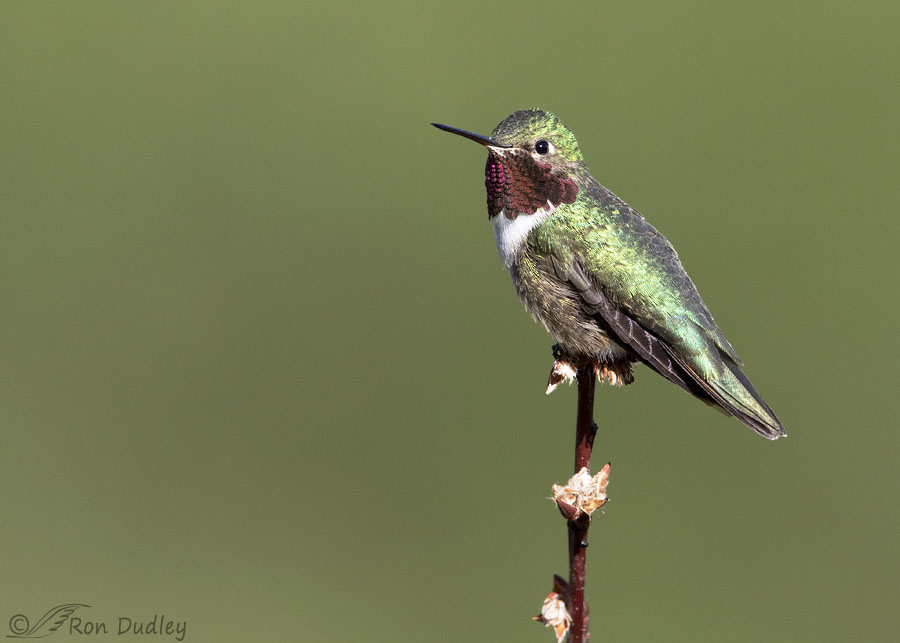
1/3200, f/5.6, ISO 800, Canon 7D Mark II, Canon EF 500mm f/4L IS II USM + EF 1.4 III Extender, not baited, set up or called in
Regular readers will recognize both this perch and the male Broad-tailed Hummingbird. The serviceberry twig is his favorite perch and I’ve been photographing him on it for a couple of weeks now. He literally thinks he owns it and I suspect he and his mate may have a nest elsewhere in the bush.
I’m only including this photo as background for some of the behavior I’ve documented below.
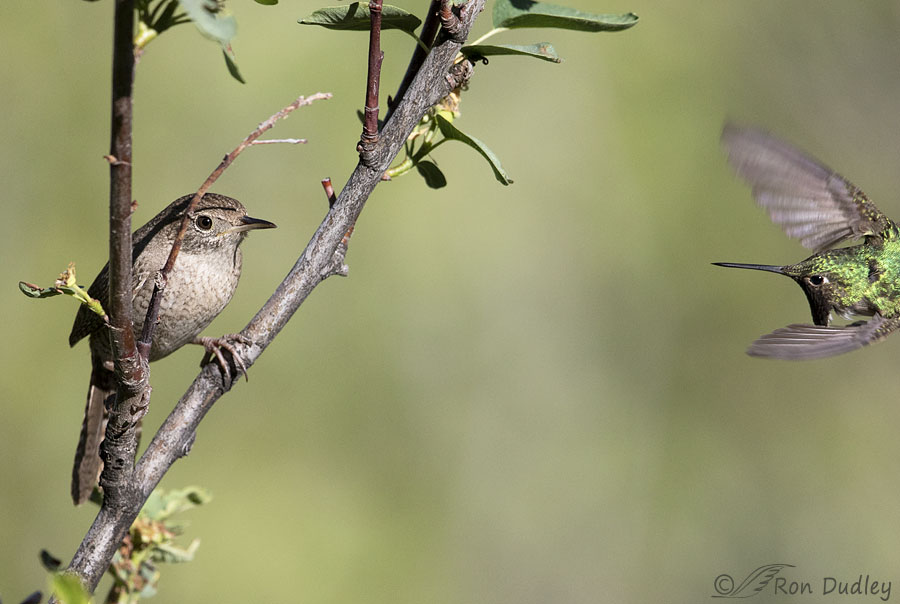
1/4000, f/5.6, ISO 800, Canon 7D Mark II, Canon EF 500mm f/4L IS II USM + EF 1.4 III Extender, not baited, set up or called in
On most days there’s a lot going on in that serviceberry bush involving other species. This house wren is nesting only a few feet from the bush and to the dismay of the hummer it regularly perches in the same serviceberry bush. Yesterday morning I took an entire series of photos as the hummer harassed the wren but it wasn’t easy to do well.
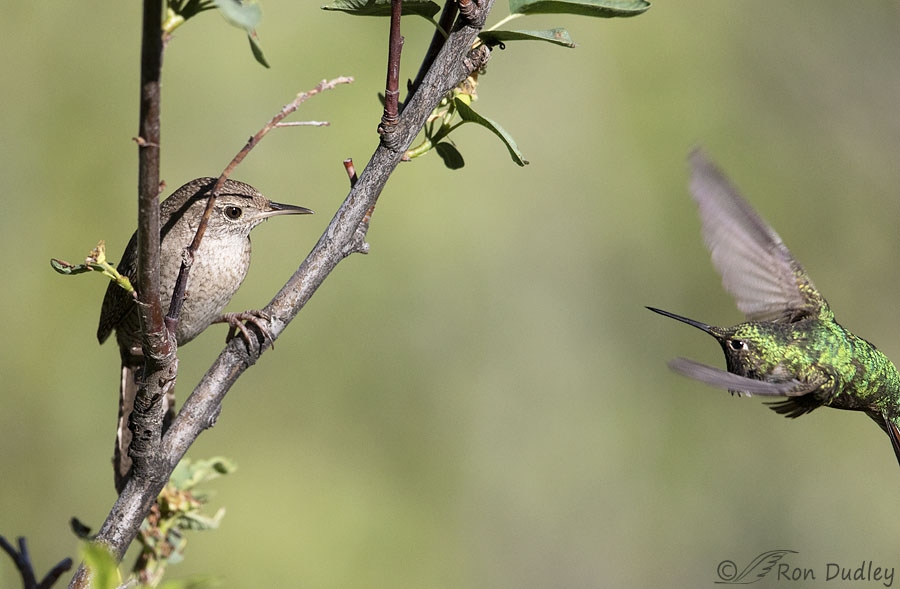
1/3200, f/5.6, ISO 800, Canon 7D Mark II, Canon EF 500mm f/4L IS II USM + EF 1.4 III Extender, not baited, set up or called in
Whenever the hummingbird was close enough to the wren to get them both entirely in frame the two birds were always in different planes relative to my camera so the hummer was always dreadfully soft (I had prefocused on the wren). When he was further away and sharp I always cut off body parts. But at least I documented the behavior.
The hummer kept coming in closer and closer to the wren and eventually drove it away.
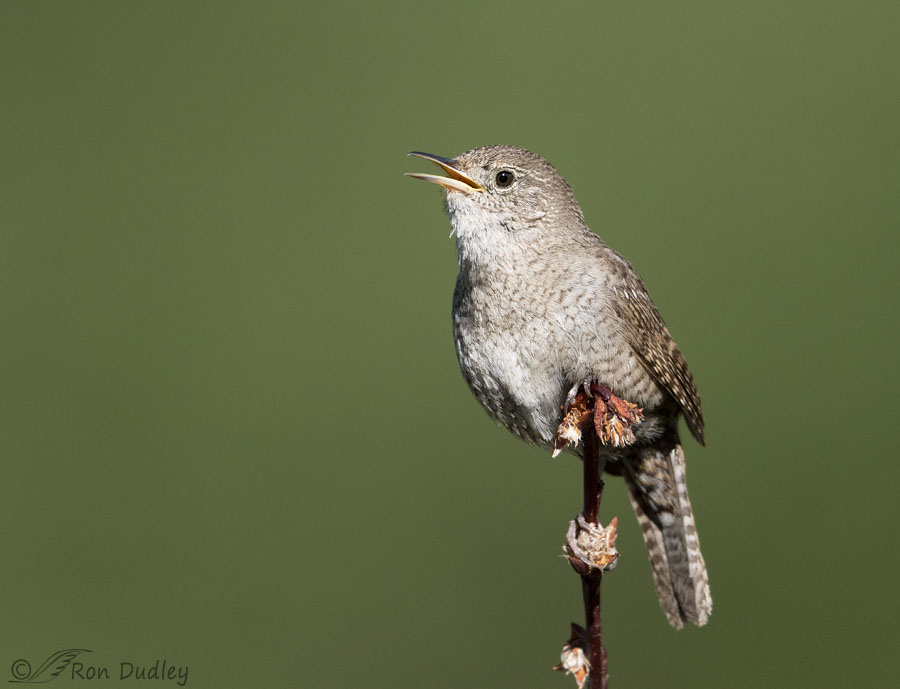
1/3200, f/5.6, ISO 800, Canon 7D Mark II, Canon EF 500mm f/4L IS II USM + EF 1.4 III Extender, not baited, set up or called in
But soon the wren showed the hummingbird who’s really king of the hill by taking possession of the hummer’s favorite perch in the same bush and declaring his dominance with song. The hummer buzzed the wren a few times but never came anywhere near as close to it as it had before. Apparently the hummer felt less safe coming in close with the larger bird on a more exposed perch.
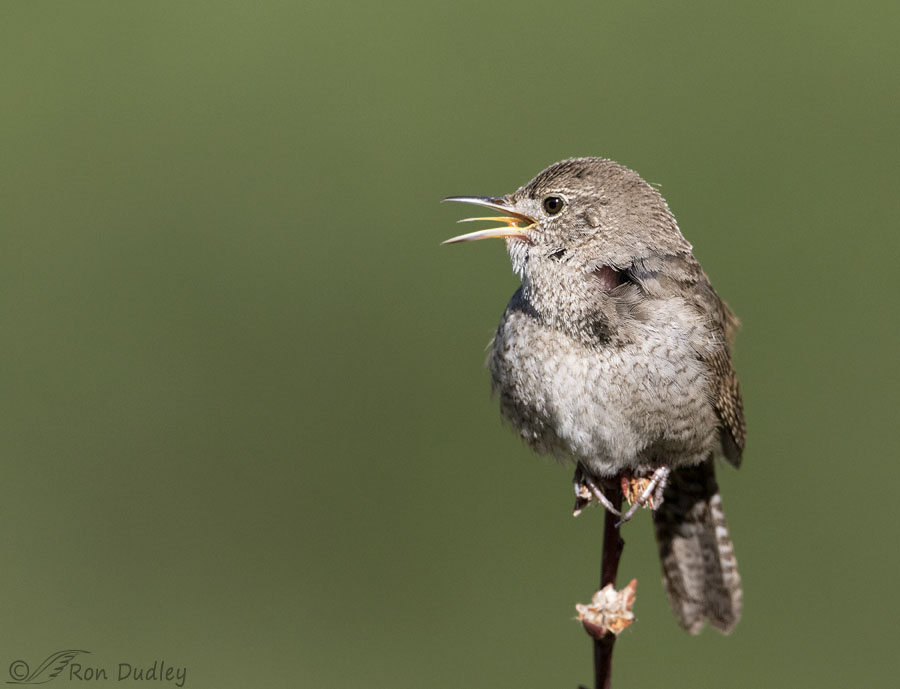
1/3200, f/6.3, ISO 800, Canon 7D Mark II, Canon EF 500mm f/4L IS II USM + EF 1.4 III Extender, not baited, set up or called in
But soon the wren’s behavior changed – at first it was a subtle change but I knew what it signified. Suddenly when its beak was open it wasn’t singing and its tongue was out. When combined with other cues I knew he was retching in preparation for throwing a pellet. So I simply laid on my shutter button in a long burst and hoped I’d be able to capture the pellet as it was ejected.
With small birds like this the pellet is ejected extremely fast – the tenth of a second between shots in a burst with my camera is an eternity and I knew my chances weren’t very good.
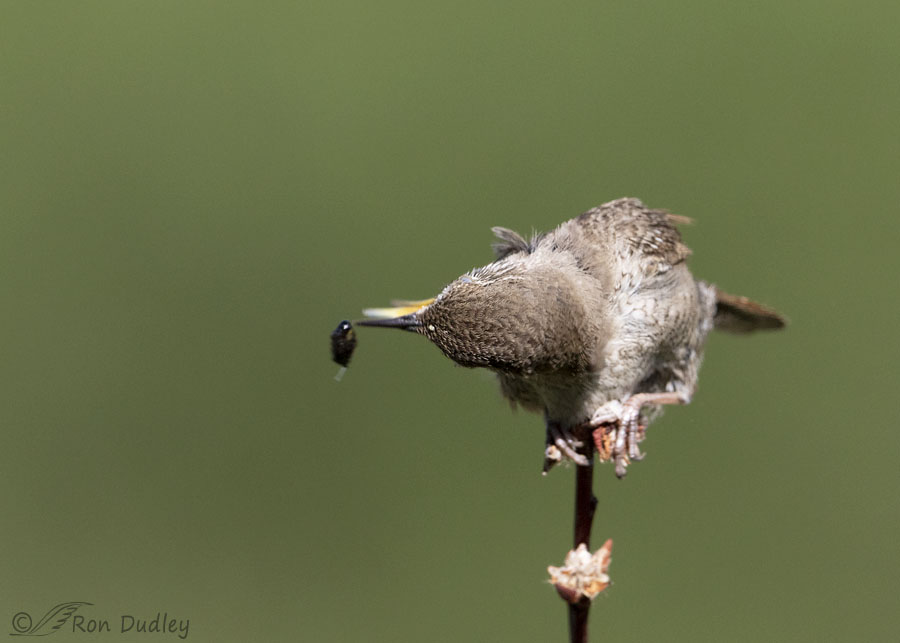
1/3200, f/6.3, ISO 800, Canon 7D Mark II, Canon EF 500mm f/4L IS II USM + EF 1.4 III Extender, not baited, set up or called in
But thankfully I got lucky. Very little in the shot is sharp but I did document the behavior.
Sometimes in bird photography small victories are about all we can hope for.
Ron
Notes:
- Whenever I see a pellet like this one I always wonder how many dozens of tiny insects paid the ultimate price to build up a mass of indigestible exoskeleton chitin as large as this one.
- It was an adventure yesterday morning to say the least. When I tried to start my pickup after photographing these birds my battery was dead. We were on a relatively isolated gravel road, we were several miles from any cell signal and I can’t walk that far with my bad back anyway – not even close. We were screwed! But after about five minutes along came “Officer Friendly” – a Sherriff’s Deputy named Ben. He had a “jump box” battery pack but it didn’t have enough charge left to start my pickup. But I always carry jumper cables so we were able to get it started using his battery and my cables. I ended up having to buy a new battery but still felt lucky as hell thanks to the Sheriff’s Deputy. Thank you, Ben!


Nice documentation of the behavior. I have been able to photograph a kestrel and a mockingbird doing this. In the latter case the pellet had fallen almost to the bottom of the frame. Just this week I saw a Loggerhead Shrike start gagging but it was out on our back patio and I was having lunch. Did see the pellet. The Bald Eagles usually upchuck gooey stuff mixed with solids, not a pretty sight! Glad you were rescued by Deputy Ben!
Amazing interesting series Ron!
Charlotte
Thank you, Charlotte.
The look on both of their faces. Bound and determined! Nice series of shots.
Thank you, Jean.
Decidely better out than in. And an excellent capture.
I have never seen pellet throwing by any bird. And have been looking out for it since one of your posts (waaaay back) alerted me to it.
The aggression I do see. Regularly. In a range of species. Pecking order is NOT an empty phrase.
EC, pellet throwing doesn’t happen often and it’s often quick so it’s easy to miss. I hope you see it happen some day.
Hummingbirds are fearless. I’ve seen them harass perched Red=tailed Hawks and even a Bald Eagle once. I’m sure they know that they can easily out-fly any of these birds so they are in no danger. You say you suspect a nest nearby, but, if so, he had nothing to do with that. Male hummingbirds, of all species, including all tropical species, have nothing to do with nesting or raising young. They simply try to attract as many females as they can and mate as frequently as possible with as many females as he can attract. No pair-bond is ever formed. After mating the female goes off to select a spot to to lay her eggs. She may or may not have already built a nest. She does all of the nest-bulilding, incubation and raising of the young with the male playing no role or ever coming to her again.
As for wrens, I remember once reading a paper where the observers once counted a House Wren pair making over 500 trips per day to feed the youngsters in the nest. That’s a lot of insects and, of cource they are feeding themselves as well during that time so it’s easy to see that a pellet will need to be cast from time to time, although I’ve never been lucky enough to see it.
“No pair-bond is ever formed”
Thanks for pointing that out, Dan. I knew it but just forgot about it when writing this post. The implication of what I wrote needed to be corrected.
I assumed you really knew, but the teacher in me just took over.Old teaching habits are hard to break.
If anyone gets that, it’s me.
It’s guys like you who have the patience and tenacity to stay on the subject, knowing the cues, ready to fire the camera at any second that enriches us with the knowledge of animal behavior! Wonderful series and post.
Many thanks for sharing!
Dick, I find it ironic that I usually have plenty of patience when it involves bird photography, especially when behaviors are involved, but I have so little of it in other aspects of my life.
Should have checked your comment yesterday, but got too busy. All this means is you are just getting older. I understand completely!
Superb series!
Thanks, Nicky.
Never a dull moment with you. 😉 Glad you were able to get a jump.
What a wonderful series! You really hit the jackpot! The hummer’s face and body are sharp and he definitely looks pissed off. The softness of his wings adds to the frenzy, in my opinion. I don’t think those shots would be as exciting if every part were tack sharp.
I actually did laugh out loud when I saw the wren on Mr. Hummer’s favorite perch. Plus, in the pre-retch shot it looks like the wren is sticking his tongue out at his harasser.
“Never a dull moment with you”
That’s true more often than I like it to be, Marty. Sometimes just a little “normalcy” would be nice because I’m not a fan of drama when it involves me…
Great series. Love number 3 with the wren’s look of, ”Really?”
Thanks, Arwen.
Great series Ron. That third photo is just incredible with the stare-down. And the posture in the pellet toss is very cool with the Wren really getting into it!
All the shots are great. Glad you got a quick jump, need to dig out my cables just in case.
You just never know about batteries, Dave. I’ve been thinking about buying a jump box for years and never got around to it. I’ll be buying one soon.
Very nice documentary. I’ve shot wrens singing and never seen their tongues, this is very interesting, something to watch out for next time. I thought the smaller hummer would be “pecking” on the larger wren, as is typically the case i see with the pecking order between a black bird and a crow, and a crow versus a hawk. Thank you.
Elmer, In this case the hummer never got quite close enough to make physical contact to the wren but he was extremely persistent and eventually the wren had had enough and flew away. At least for a few minutes before he claimed the hummer’s favorite perch as his own.
COOL! 🙂 Those wrens are feisty but then so are the hummers.:) LOVE the 2nd photo – determined hummer going GRRRR! 🙂 Would never have thought of wrens throwing pellets…. Watched a Nighthawk chase another last evening squawking at it all the way – new to me! Half dozen over the creek with VERY dark wings that REALLY showed the action – THAT will make you dizzy! 😉 Wait and see on wheat – didn’t flatten it BUT can’t walk it yet so “spots” won’t don’t show at the moment.
That nighthawk experience must have been fun.
Back in the late 50’s after a devastating hailstorm that wiped out the entire crops for many of us a farmer close to us (his last name was Bloat if I remember correctly) bought (or leased, can’t remember) some kind of vacuuming machinery that he hoped would vacuum all of the shelled grain off of the ground. Needless to say it didn’t work and he really suffered financially that year. He spent a lot of money on the machinery and ended up having no crop to pay for it. Or to live on.
Farming is tough!
Excellent photography Ron – really hard to photograph a moving hummingbird and a stationary wren. Great job. Nature at its best. Love the hostile look in the hummingbird’s eye.
Everett, that type of shot is always difficult but I was surprised how difficult it was in this case. You’d think when the hummer was closer to the wren they’d be more likely to be in the same plane but this time he never was.
And I had a hard time getting enough shutter speed AND depth of field to get everything sharp.